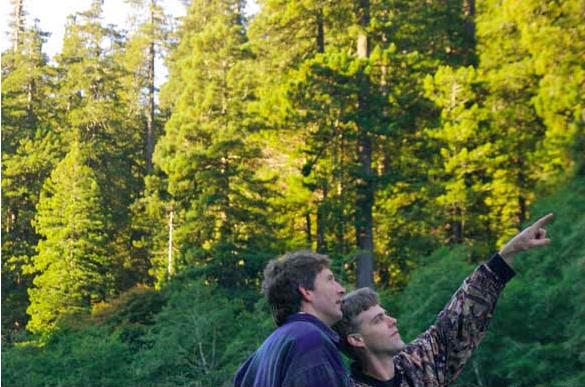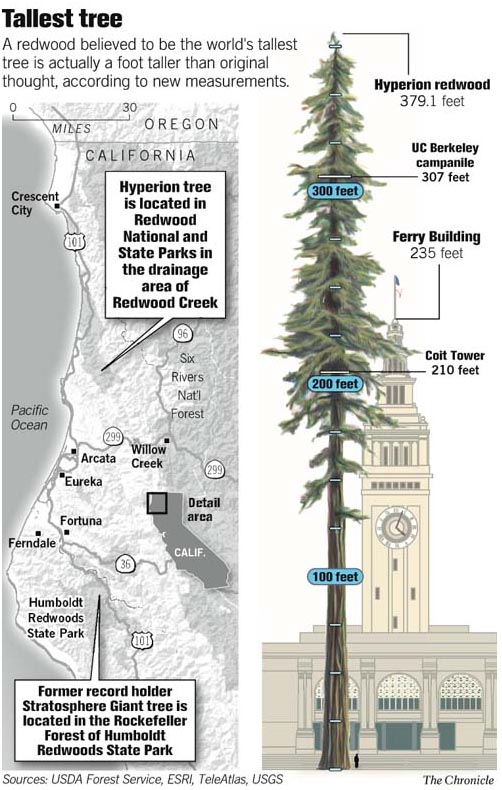
|
The World's Tallest Tree: A Redwood
First posted Octrober 2, 2006
Last updated October 2, 2006
From the SF Chronicle, September 29, 2006
Researchers have confirmed that a 379.1-foot tree in Redwood National and State Parks is the world's tallest -- a foot higher, even, than originally thought. And the naturalists who discovered the tree say it's unlikely that they'll find a taller redwood. The tree, which the discoverers named Hyperion, displaces the Stratosphere Giant, a redwood in Humboldt State Park, as the world-record holder. Two other recently-discovered trees in Redwood National Park have also measured taller than the 370.5-foot Stratosphere Giant. Although researchers took laser measurements of all three of the redwoods this summer, final measurements had to wait until the end of the marbled murrelet's nesting season. The endangered seabird broods in old-growth conifers.

About two weeks ago, one day after the murrelet nesting season ended, Humboldt State University forestry Professor Steve Sillett climbed Hyperion and dropped a measuring tape to the ground. Sillett, who specializes in the ecology of ancient forest canopies, has received global attention for both his academic work and his prowess in scaling the world's tallest living organisms. Climbing the world's tallest tree to the top was no small feat, said Michael Taylor, an amateur naturalist who, with partner Chris Atkins, discovered the three trees this summer. Sillett used a powerful crossbow to shoot a bolt with a trailing line over a limb about 250 feet up the redwood's trunk. The line was fixed to a rope, which was pulled over the limb and anchored to a nearby tree. Sillett and three other climbers ascended the rope into the canopy. Chances of finding a tree that could best or even equal the new champ are remote, Taylor said. "Between us, Chris and I have already covered about 95 percent of the prime habitat for big redwoods," Taylor said. "There aren't too many more places we could look." Hyperion, which may be 700 to 800 years old, could have been taller but for woodpecker damage at the top. "It's possible it could've topped out at 380 feet," Taylor said. Four decades ago, there were thousands of trees Hyperion's size, but they were logged along with more than 90 percent of the state's ancient redwoods. "Thirty years ago, they were cutting in 24-hour shifts (in the basin where Hyperion is located), using headlamps at night," Sillett said. The only thing that saved Hyperion, Sillett said, is the expansion of Redwood National Park in 1978, just before the remaining giants were wiped out. Sillett said redwoods can't reach Hyperion's the lofty heights unless they are protected from wind. In the original old-growth coast redwood forests, the giant trees themselves comprised the windbreak. A universal constraint on tree height is getting water up the trunk and to the treetops. Sillett said the tallest tree reliably recorded was a Douglas fir in British Columbia's Lynn Valley, measured in the late 19th century at 414 feet.
"We don't have a generalized limit on tree height yet because it can vary greatly depending on soil and climate," Sillett said. "But our research indicates (the Lynn Valley fir) may be close to the limit."


Riparian
Biozone
Oak Woodland
Biozone
Chaparral Biozone
Grassland Biozone
Trees and
Capillary Action
The Age of Redwood
Trees
|

|

